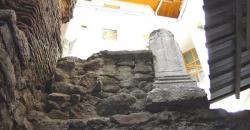INSTITUT SUPERIEUR D'ANTHROPOLOGIE
INSTITUTE OF ANTHROPOLOGY
ONLINE COURSES / COURS A DISTANCE
SPRING TERM : APRIL 2016
REGISTER NOW
TURQUIE – 
 Ankara - The only structure from the Byzantine era in Ankara, the Saint Clement Church, is about to disappear amid the city’s continuing urban sprawl. Although it is a very important cultural artifact, the Saint Clement Church is in ruins due to neglect and requires serious attention. The church is located between Denizciler Avenue and Çıkrıkçılar Slope in the Ulus neighborhood, behind the old courthouse building. Saint Clement, an Ankara bishop who worked to spread Christianity, was born in Ankara in 283. He was killed by the Emperor Diocletian (284-305), who was known for his massacres of Christians, in 303. He was later declared a saint by the Orthodox Church, while a church was built in his name in the Byzantine era. Many historians have different views about the history of the Saint Clement Church. The church is generally believed to have been built between the fourth and ninth centuries. It is known that at the time of the Ottoman Sultan Murad II, a mosque and madrasah were built on top of Saint Clement’s by Ahmed Bin Hızır Yeğen Bey. In a fire in 1917, the two structures were completely burned, but the structure’s minaret survived for some time before also being removed in 1925. Today, only the interior façade of a wall and marble blocks from the church have survived.
Ankara - The only structure from the Byzantine era in Ankara, the Saint Clement Church, is about to disappear amid the city’s continuing urban sprawl. Although it is a very important cultural artifact, the Saint Clement Church is in ruins due to neglect and requires serious attention. The church is located between Denizciler Avenue and Çıkrıkçılar Slope in the Ulus neighborhood, behind the old courthouse building. Saint Clement, an Ankara bishop who worked to spread Christianity, was born in Ankara in 283. He was killed by the Emperor Diocletian (284-305), who was known for his massacres of Christians, in 303. He was later declared a saint by the Orthodox Church, while a church was built in his name in the Byzantine era. Many historians have different views about the history of the Saint Clement Church. The church is generally believed to have been built between the fourth and ninth centuries. It is known that at the time of the Ottoman Sultan Murad II, a mosque and madrasah were built on top of Saint Clement’s by Ahmed Bin Hızır Yeğen Bey. In a fire in 1917, the two structures were completely burned, but the structure’s minaret survived for some time before also being removed in 1925. Today, only the interior façade of a wall and marble blocks from the church have survived.
http://www.hurriyetdailynews.com/last-byzantine-church-in-ankara-close-to-disappearing.aspx?PageID=238&NID=94901&NewsCatID=375
BULGARIE –  Candidian - An unknown statue of Roman Emperor Trajan (r. 98-117 AD) with a rich decoration of motifs from the ancient mythology has been kept for decades at the Laboratory of Bulgaria’s National Museum of History. The bronze statue of Emperor Trajan, whose decorations feature gods and heroes from the Antiquity, was found during excavations of the Roman road station and fortress Candidiana located near the town of Malak Preslavets on theDanube River in Northeast Bulgaria. It was discovered in the 1980s but its finding has never been announced, and it has never been shown to the public, according to a report of the Bulgarian daily Standart. After his victorious wars against theDacians north of the Danube, Roman Emperor Trajan stationed the eliteClaudius’ 11th Legion (Legio XI Claudia) atDurostorum (Dorostorum), today’sSilistra. Some of the legion’s detachments were stationed at Candidiana from the last quarter of the 3rd century until the middle of the 4th century. The Candidana Fortress itself ended up surviving until the Early Byzantine period, i.e. the end of 6th – beginning of the 7th century when it was destroyed in barbarian invasions.
Candidian - An unknown statue of Roman Emperor Trajan (r. 98-117 AD) with a rich decoration of motifs from the ancient mythology has been kept for decades at the Laboratory of Bulgaria’s National Museum of History. The bronze statue of Emperor Trajan, whose decorations feature gods and heroes from the Antiquity, was found during excavations of the Roman road station and fortress Candidiana located near the town of Malak Preslavets on theDanube River in Northeast Bulgaria. It was discovered in the 1980s but its finding has never been announced, and it has never been shown to the public, according to a report of the Bulgarian daily Standart. After his victorious wars against theDacians north of the Danube, Roman Emperor Trajan stationed the eliteClaudius’ 11th Legion (Legio XI Claudia) atDurostorum (Dorostorum), today’sSilistra. Some of the legion’s detachments were stationed at Candidiana from the last quarter of the 3rd century until the middle of the 4th century. The Candidana Fortress itself ended up surviving until the Early Byzantine period, i.e. the end of 6th – beginning of the 7th century when it was destroyed in barbarian invasions.
http://archaeologyinbulgaria.com/2016/02/08/unknown-richly-decorated-statue-of-roman-emperor-trajan-kept-in-storage-of-national-museum-of-history-for-decades/
ROYAUME UNI –  Staffin Bay - The remains of hazelnuts found during an archaeological dig in Skye are more than 8,000-years-old, laboratory tests have confirmed. Hazelnuts were a favourite snack of Mesolithic hunter-gatherers, according to archaeologists at the University of the Highlands and Islands (UHI). The shells were discovered during an excavation above Staffin Bay last year.
Staffin Bay - The remains of hazelnuts found during an archaeological dig in Skye are more than 8,000-years-old, laboratory tests have confirmed. Hazelnuts were a favourite snack of Mesolithic hunter-gatherers, according to archaeologists at the University of the Highlands and Islands (UHI). The shells were discovered during an excavation above Staffin Bay last year.
http://www.bbc.com/news/uk-scotland-highlands-islands-35533108